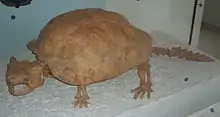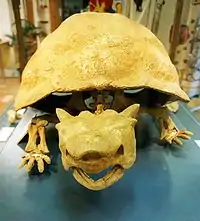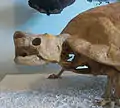Meiolania
Meiolania ("small roamer") is an extinct genus of stem-turtle[2][3] from the Middle Miocene to Late Pleistocene and possibly Holocene.
| Meiolania | |
|---|---|
 | |
| Cast of a Meiolania platyceps skeleton, American Museum of Natural History | |
| Scientific classification | |
| Kingdom: | Animalia |
| Phylum: | Chordata |
| Class: | Reptilia |
| Family: | †Meiolaniidae |
| Genus: | †Meiolania Owen, 1886[1] |
| Species | |
| Synonyms | |
| |
Description
Meiolania had an unusually shaped skull that sported many knob-like and horn-like protrusions. Two large horns faced sideways, and would have prevented the animal fully withdrawing its head into its shell. The tail was protected by armored 'rings', and sported thorn-like spikes at the end.[4] The body form of Meiolania may be viewed as having converged towards those of dinosaurian ankylosaurids and xenarthran glyptodonts.
There are two species of Meiolania known from the Australian continent: M. brevicollis and an unnamed species. The unnamed species could reach 2 metres (6.6 ft) in carapace length, making it the second-largest known nonmarine turtle or tortoise, surpassed only by Megalochelys atlas from Asia, which lived in the Pleistocene. The smallest species in turn was M. mackayi from New Caledonia, with a carapace length of 70 centimetres (2.3 ft). Another insular species is known from Lord Howe Island, M. platyceps.
Behavior
Meiolania fed on plants. Because the remains known by 1925 were found close to beaches, it was thought to be aquatic. It is now known to have been terrestrial. However, a more recent study demonstrates that they were in fact coastal species that occupied a niche similar to that of the modern marine iguana.[5]
Discovery and species

The genus was erected in 1886 based on remains found on Lord Howe Island, which Richard Owen assigned to the two species M. platyceps and M. minor (now a synonym of the former).[1] These were the first good meiolaniid remains, and were used to show that the first known remains of a related animal, a species from Queensland now known as Ninjemys oweni (which was assigned to Meiolania until 1992), did not belong to lizards as initially thought, but to turtles.[6] Woodward sank Niolamia argentina into Meiolania, but this was not accepted by later authors.
In New Caledonia, M. mackayi was described from Walpole Island in 1925. It was smaller and less robust than M. platyceps.[7] Meiolania remains are also known from the Pindai Caves, Grande Terre, and from Tiga Island. M. brevicollis was described in 1992 from the mid-Miocene Camfield Beds of northern Australia, and differed from M. platyceps in having a flatter skull and other horn proportions.[8]
A second undescribed species of Meiolania from mainland Australia is known from the Wyandotte Creek locality in Queensland, dated to the Late Pleistocene, consisting of three horn cores and a caudal vertebra, noted to be "unusually large" in size. This species is referred to as M. cf platyceps, as the remains are most similar to M. platyceps but are not diagnostic beyond genus level.[9][10]
Holocene remains of turtles from Vanuatu found in Lapita culture middens were referred to Meiolania in 2010 as the new species ?M. damelipi[11] However, upon closer inspection their morphology appears to be non-meiolaniiform, and no parietal horns, a distinctive characteristic of Meiolania have been found at any locality in Vanuatu, despite being one of the most common finds on Walpole and Lord Howe. The long bone morphology agrees more closely with a tortoise identification, a group which has otherwise not been reported from the South Pacific or Australasia.[12] Further remains, attributable to ?M. damelpi or a closely related form, have been found in various parts of the Fijian archipelago, including Viti Levu, Vanua Levu, and some smaller islands.[13][14]
Extinction
It is thought that M. platyceps went extinct on Lord Howe Island before human occupation as a result of postglacial sea level rise.[11]
Gallery
 Front view of M. platyceps fossil, Lord Howe Island museum
Front view of M. platyceps fossil, Lord Howe Island museum The tail of Meiolania platyceps (AMNH 29076)
The tail of Meiolania platyceps (AMNH 29076).jpg.webp) Meiolania platyceps, Lord Howe Island Maritime Museum
Meiolania platyceps, Lord Howe Island Maritime Museum The skull of Meiolania platyceps (AMNH 29076)
The skull of Meiolania platyceps (AMNH 29076)
References
- Owen, Richard (January 1, 1886). "Description of Fossil Remains of Two Species of a Megalanian Genus (Meiolania) from "Lord Howe's Island"". Philosophical Transactions of the Royal Society. 177: 471–480. Bibcode:1886RSPT..177..471O. doi:10.1098/rstl.1886.0015.
- Joyce, Walter G. (April 2007). "Phylogenetic relationships of Mesozoic turtles". Bulletin of the Peabody Museum of Natural History. 48: 3–102. doi:10.3374/0079-032X(2007)48[3:PROMT]2.0.CO;2.
- Anquetin, Jérémy (2012) [9 November 2011]. "Reassessment of the phylogenetic interrelationships of basal turtles (Testudinata)". Journal of Systematic Palaeontology. 10: 3–45. doi:10.1080/14772019.2011.558928.
- Palmer, D., ed. (1999). The Marshall Illustrated Encyclopedia of Dinosaurs and Prehistoric Animals. London: Marshall Editions. p. 67. ISBN 1-84028-152-9.
- https://www.researchgate.net/publication/328734180_THE_ECOLOGY_OF_MEIOLANIA_PLATYCEPS_A_PLEISTOCENE_TURTLE_FROM_AUSTRALIA
- Anderson, C. (1925). "Notes on the extinct Chelonian Meiolania, with a record of a new occurrence" (PDF). Records of the Australian Museum. 14 (4): 223–242. doi:10.3853/j.0067-1975.14.1925.844.
- Megirian, D. (1992). "Meiolania brevicollissp. Nov. (Testudines: Meiolaniidae): A new horned turtle from the Australian Miocene". Alcheringa: An Australasian Journal of Palaeontology. 16 (2): 93–106. doi:10.1080/03115519208619035.
- G. C. McNamara. 1990. The Wyandotte Local Fauna: A New, Dated, Pleistocene Vertebrate Fauna from Northern Queensland. Memoirs of the Queensland Museum 28:285-297
- GAFFNEY, E.S. AND G. MCNAMARA. 1990. A meiolaniid turtle from the Pleistocene of Northern Queensland. Memoirs of the Queensland Museum 28:107–113.
- White, A. W.; Worthy, T. H.; Hawkins, S.; Bedford, S.; Spriggs, M. (2010-08-16). "Megafaunal meiolaniid horned turtles survived until early human settlement in Vanuatu, Southwest Pacific". Proc. Natl. Acad. Sci. USA. 107 (35): 15512–15516. Bibcode:2010PNAS..10715512W. doi:10.1073/pnas.1005780107. PMC 2932593. PMID 20713711.
- Sterli, Juliana (April 2015). "A Review of the Fossil Record of Gondwanan Turtles of the Clade Meiolaniformes". Bulletin of the Peabody Museum of Natural History. 56 (1): 21–45. doi:10.3374/014.056.0102. ISSN 0079-032X.
- Worthy, T. H.; Anderson, A. J.; Molnar, R. E. (1999). "Megafaunal expression in a land without mammals-the first fossil faunas from terrestrial deposits in Fiji (Vertebrata: Amphibia, Reptilia, Aves)". Senckenbergiana Biologica. 79 (2): 237–242. Retrieved 2012-03-04.
- Hawkins, Stuart; Worthy, Trevor H.; Bedford, Stuart; Spriggs, Matthew; Clark, Geoffrey; Irwin, Geoff; Best, Simon; Kirch, Patrick (December 2016). "Ancient tortoise hunting in the southwest Pacific". Scientific Reports. 6 (1): 38317. Bibcode:2016NatSR...638317H. doi:10.1038/srep38317. ISSN 2045-2322. PMID 27922064.
Further reading
- Cox, Barry; Harrison, Colin; Savage, R. J. G.; Gardiner, Brian; Palmer, Douglas (1999). The Simon & Schuster Encyclopedia of Dinosaurs and Prehistoric Creatures: A Visual Who's Who of Prehistoric Life. Simon & Schuster. ISBN 0-684-86411-8. OCLC 40943525.
External links
| Wikimedia Commons has media related to Meiolania. |
| Wikispecies has information related to Meiolania. |
- Meiolania platyceps Owen (The Australian Museum; photo)

